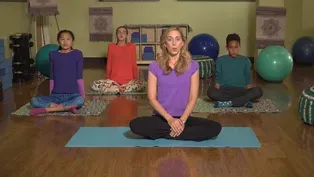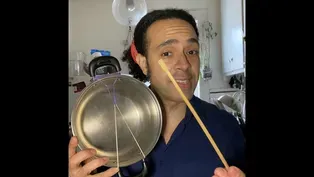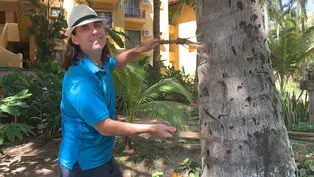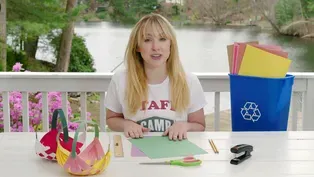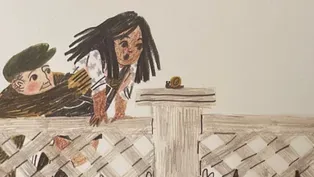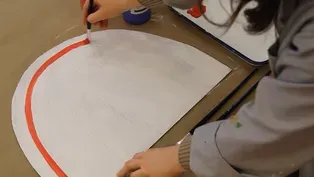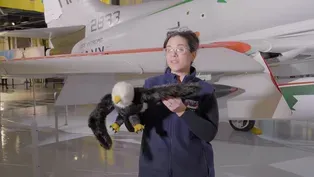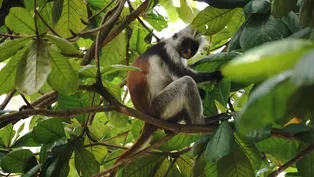
Going Green Day
7/1/2022 | 28m 46sVideo has Closed Captions
Make instruments and kites, take snake breaths, learn about traits birds and planes share.
Make instruments, take snake breaths. Welcome to CAMP TV—a half-hour day camp experience in your living room! Head counselor Zachary Noah Piser and his new co-counselor, Mia Weinberger, guide "campers" as they learn through play. Content partners include the Children’s Museum of the Arts, East Tennessee PBS, Intrepid Museum, Lincoln Center, Nature, NY Philharmonic, PBS39, San Diego Zoo, WHRO.
Problems with Closed Captions? Closed Captioning Feedback
Problems with Closed Captions? Closed Captioning Feedback
Camp TV is a local public television program presented by THIRTEEN PBS

Going Green Day
7/1/2022 | 28m 46sVideo has Closed Captions
Make instruments, take snake breaths. Welcome to CAMP TV—a half-hour day camp experience in your living room! Head counselor Zachary Noah Piser and his new co-counselor, Mia Weinberger, guide "campers" as they learn through play. Content partners include the Children’s Museum of the Arts, East Tennessee PBS, Intrepid Museum, Lincoln Center, Nature, NY Philharmonic, PBS39, San Diego Zoo, WHRO.
Problems with Closed Captions? Closed Captioning Feedback
How to Watch Camp TV
Camp TV is available to stream on pbs.org and the free PBS App, available on iPhone, Apple TV, Android TV, Android smartphones, Amazon Fire TV, Amazon Fire Tablet, Roku, Samsung Smart TV, and Vizio.
Providing Support for PBS.org
Learn Moreabout PBS online sponsorship♪♪ This program was made possible by the Corporation for Public Broadcasting, a private corporation funded by the American people.
Additional funding was provided by the following: The Charles and Lucille King Foundation, the New York City Council, the Alice Lawrence Foundation, the Pine Tree Foundation of New York, the Peter G. Peterson and the Joan Ganz Cooney Fund.
♪♪ ♪ Camp TV ♪ ♪ It's time for us to start ♪ ♪ From furry animal encounters ♪ ♪ To some reading and the arts ♪ ♪ No matter what the weather ♪ ♪ We'll explore it all together ♪ ♪ It's a place for you and me ♪ ♪ It's "Camp TV" ♪♪ Hi, campers!
Ready to go green?
I know I am.
What do you think?
Oh, hi, Zach.
Oh, hi, Mia.
How is my favorite co-counselor doing today?
I'm good.
Thanks.
What's going on?
What do you mean?
Going green is what's going on.
Where's yours?
Where's my what?
Your green.
You didn't forget that today's Going Green Day, did you?
Oh, no, I definitely did not.
Un, Zach.
Mia.
I'm pretty sure going green doesn't mean what you think it means.
[ Scoffs ] What are you talking about?
How much greener can a guy get?
[ Chuckles ] [ Chuckles ] Are you feeling green with envy?
[ Laughs ] No!
I mean, yes, your outfit is totally awesome, and green really does look great on you.
Thank you.
But I'm pretty sure green is much more than just a color.
Go on.
As I understand it, "going green" means taking extra steps to protect the Earth not just today, but every day.
In fact, I was just heading to the recycling bin to drop off these water bottles I collected at the lake, and I got this construction paper.
Why just use one side when you can use two?
[ Gasps ] These will be great for arts and crafts.
Of course [Clears throat] going green.
Right, making decisions to reuse, reduce, and recycle whenever possible.
Right, I try to turn off the lights whenever I leave the room or by giving clothing that I've outgrown to friends.
Mia.
Yeah, Zach.
Might I interest you in a spare peapod outfit?
I thought you'd never ask.
Look at us!
Two peas in a pod.
[ Both ] Welcome to Going Green Day on "Camp TV".
See you after your first few activities.
A little birdie told me it's time to go wild.
Olivia: We all understand the importance of recycling, and most of us try to remember to dispose of our waste in the correct way.
But did you know that humans aren't the only ones who follow the recycling rule?
Meet the American burying beetle, one of nature's most efficient and fascinating recyclers.
I hope you're ready to hear this one, because it sounds like a scene from a horror movie.
These beetles essentially recycle dead animal bodies.
♪♪ Once they have located their target, they work together to bury the carcass underground.
They then remove all the feathers or fur and coat the remaining carrion in saliva-like secretions to preserve it, almost like a mummy.
Not gross enough for you yet?
Well, they then lay their eggs inside the carcass so the hatchlings have something to feed on.
Recycling at its finest, you could say.
While their story may sound a little gruesome to you and I, the American burying beetle is a necessary part of our ecosystem.
These insects are responsible for recycling decomposing components back into the environment.
But unfortunately, this species is in trouble.
They have been disappearing at an alarming rate.
But the keepers and conservationists from the Saint Louis Zoo are lending a helping hand.
Bob: We are at the Wah-Kon-Tah Prairie site, which is about four and a half hours southwest of the Saint Louis Zoo.
And we're trying to re-introduce American burying beetles back to the site where they once used to live in the hopes of establishing a self-sustaining population of these beetles that don't need our help anymore.
Olivia: So where do these beetles come from?
Every beetle that we have released into the wild was raised at the Saint Louis Zoo, Olivia: Bob isn't alone on his quest to re-introduce this incredible, little beetle back into the environment.
He is joined by the teen volunteers from Zoo ALIVE.
And it's safe to say they are pretty passionate about this project.
John: My favorite part about working with the American burying beetles, or as we know them, as the ABBs, is that I get to release them into the wild.
You have no idea how important it is to me that I'm helping to save an endangered species in the wild.
I mean, that's really cool.
And just being here to release them and seeing them grow and evolve and just become maybe more common in the wild.
It just -- that's all me.
I'm here to help them, and I love it.
♪♪ Juliana: It makes me feel great to be a teen volunteer and do all this different work.
I can say that I've held an endangered species in my hand.
We're digging holes.
It's not exactly easy work, but it's super fun.
It's really cool to be able to talk to all the different people who are obviously a little more experienced in the field and kind of talk to them about their experiences and just get experience.
Olivia: Thanks to the incredible work of Bob and his team of passionate conservationists together with the U.S.
Fish and Wildlife Service, the Missouri Department of Conservation, and the Nature Conservancy, the American burying beetle may have a second chance.
♪♪ Arts and crafts?
Yes, please!
Let's Get Artsy.
I'm gonna make a string instrument.
[ Strumming ] ♪♪ What are the key ingredients?
A tense string.
A chamber opening.
Vibration.
Tension makes tone and pitch.
More tension... Looser... Find something hollow with an opening like a box, a pot.
Openings amplify the tone.
The strings vibrate when we hit, pluck, or drive them.
I made this in the kitchen.
Tense string, open space, and this to hit it.
Check it out.
[ Strumming ] ♪♪ What can you make with those ingredients at home?
Curiosity and wonder.
Let's discover together.
It's Science Wow!
♪♪ ♪ I've got a big bin ♪ ♪ It's for recycling ♪ ♪ And I can fill it up with stuff I've already used ♪ ♪ A big truck takes them away ♪ ♪ And whoo-hey!
♪ ♪ In just a couple of months ♪ ♪ It'll become something new ♪ ♪ Paper, bottles, and cans ♪ ♪ Go ahead and recycle 'em ♪ ♪ Toss 'em in the bin once you clean and flatten 'em ♪ ♪ There's too much trash, but I know I can help ♪ ♪ Saving the planet starts with yourself ♪ ♪♪ ♪ I'm checking my bin for the magic symbol ♪ ♪ And thinking about what goes in ♪ ♪ Boxes, I break 'em down ♪ ♪ Bottles, I rinse 'em out ♪ ♪ Clean cans and paper, I can do this!
♪ ♪ Hee-haw!
♪ ♪ Paper, bottles, and cans ♪ ♪ Go ahead and recycle 'em ♪ ♪ Toss 'em in the bin once you clean and flatten 'em ♪ ♪ There's too much trash, but I know I can help ♪ ♪ Saving the planet starts with yourself ♪ ♪ No plastic bags ♪ ♪ No plastic bags ♪ ♪ No food and drinks ♪ ♪ No food and drinks ♪ ♪ No toys ♪ ♪ No toys ♪ ♪ No foam ♪ ♪ No foam ♪ ♪ No straws ♪ ♪ No straws ♪ ♪ And no dogs!
♪ [ Barking, panting ] ♪ Paper, bottles, and cans ♪ ♪ Go ahead and recycle 'em ♪ ♪ Toss 'em in the bin so they can be new again ♪ ♪ There's too much trash, but I know I can help ♪ ♪ Saving the planet starts with yourself ♪ ♪ Your own math test becomes clean, new paper ♪ ♪ A can makes some more to choose to drink from later ♪ ♪ Bottles can be turned into rugs and clothes ♪ ♪ Now go show the world what you know ♪ ♪♪ Ready for some math that counts?
Count On.
Hi, everyone.
My name's Norah, and today I'm going to show you how to use math to do a fun craft at home.
We're going to make different geometric shapes into kites.
To make each kite, you'll need newspaper -- or some other kind of paper -- two sticks, tape or glue, and a long piece of string or yarn, some scissors to cut it.
The first geometric shape we're going to make is a classic kite shape or a quadrilateral.
A quadrilateral is a shape that has four sides, two pairs of equal-length sides that are touching each other.
So to start, I'm going to lay out my paper so that I can see how much I need.
And then I'm gonna build the frame for my kite with my sticks on top of it.
I'm gonna I have one and then one going across, not in the middle, but just kind of a little bit up.
Next, I'm going to attach my two sticks to each other in the middle, either by tying the string or using tape or glue.
Next, I'm gonna start at the bottom of my kite, and I'm gonna tie the string around my frame.
♪♪ Now we need to cut out the shape of our kite from the paper.
♪♪ Leave some extra room to make it bigger than your frame, because we're gonna fold it over.
♪♪ The last step is to tie another really long string right around the middle of your kite.
This is gonna be the string that you hold when you're flying.
I did that same process to take two more geometric shapes and turn them into kites.
I made a triangle which has three sides and three angles, and I made a square, or kind of a rhombus, which has four sides, all of equal length.
Now, let's take these outside and try them out.
♪♪ ♪♪ ♪♪ Well, I might need a little more practice flying my kites.
Try this at home and see what shape flies best for you.
Bye!
Who's ready for a Field Trip?
Hi!
My name is Gerrie.
I'm a museum educator here at the Intrepid Sea, Air & Space Museum.
At the museum, we have a lot of really cool airplanes, like the one behind me, the Skyhawk.
I love that it is called the Skyhawk, because today we are going to talk about how airplanes and birds are same and different.
To do that, I'm going to use my friend, Baldy.
What is one part that both a plane and a bird have that is the same?
One thing that you might think of is the wing.
A bird's wing, though, is made to flap up and down.
And an airplane wing, once extended, stays in place.
Another part that's the same is the tail.
However, on a plane they have a tail that sticks straight up.
Even the things they use to land are sort of the same.
A bird will put out its feet to land, and a plane will use its wheels or landing gear to land.
Its wheels are right under there.
I'm sure that you can think of a lot of other things that are the same and different between birds and airplanes.
Arts and crafts?
Yes, please!
Over to you, Co-Councilor Mia.
Welcome back to Going Green Day on "Camp TV".
Remember that leftover construction paper I found earlier today?
I thought we could use some of it to make a paper basket.
These are great for keeping some of your favorite items in or anything else you'd like.
You will need two colors of construction paper, some safety scissors, a ruler, a pencil, and a stapler.
This can be a little tricky to get at first, but once you get the hang of it, you'll be weaving away in no time.
Time, patience, and practice equals progress.
Start by picking two of your favorite colors of construction paper.
Some say this is the hardest part.
Now take the colors together and fold them in half and use your ruler to create lines about an inch apart like so.
♪♪ There we go.
Now cut along the lines.
♪♪ You want to make sure you have an even amount of strips for both colors.
♪♪ Just a couple more.
♪♪ Start by picking one color and lay it out flat horizontally like so.
So I'm gonna start with purple.
And we will lay these out here.
Okay.
I'm gonna start with five -- five purple, five green.
Now use the other color and begin weaving using a basic over-under technique like this.
Over, under, over, under, and over like that.
Now do the same with the next strip, but go in the opposite order.
So if you started over, start your next one under.
Under, over, under.
Like I said, this can be pretty tricky, but with time, you will get the hang of it.
Now you just keep going.
So I have three more, so I'll start this one over and go under.
♪♪ Under and over.
Looking pretty good, if I may say so myself.
And finally under.
Now continue weaving until all of your strips have been used up like this.
Then gather one side together like so.
It's tricky to keep them woven, but if you just gather them up carefully.
And then staple it together.
There you go.
Now, you might need to fix it up a little bit.
As I said, this is a little tricky, and it takes practice, but you're gonna do the same to the other side.
So I got the greens here now, and eventually it'll look like this.
Now take a different color of construction paper, staple it to one end, and then bring it up and over to the opposite end and staple that.
Now do that one more time on the other side.
So we'll staple it to the green here.
Bring it up and over and staple to the other green side.
And there you have it, your very own paper basket.
Now you can use it to collect other recyclable items found around the house.
I'm heading back to the lake.
I'm pretty sure I saw some other plastic bottle caps that can be recycled.
Music, dance, magic, and more.
Step right up to Center Stage.
Hi, everybody.
Mr. Hines here with a video about instrument construction and finding ways that you can make music with what you have where you are.
In this video, I'm going to attempt to use only the materials that I find in my natural environment.
If you have to cut anything at home, always ask for adult supervision.
These are all parts of an old, dried up palm tree.
And I'm gonna use this to make some new kind of drumsticks.
First, I'm gonna cut these really tough branches off with these pliers.
Then trim it with this garden tool.
Next, I'm gonna file away until I can get it smooth.
Now I'm going to cut it in half to get two parts.
Gather the individual branches and tie them with this cord.
Make sure it's really tight so they all stay together.
Cut off the ends so that they match.
And now I have two new kinds of sticks that I can use to make music in my environment.
[ Drumming ] ♪♪ ♪♪ ♪♪ Next, I'm gonna try to make some natural brushes using this old, dried up palm leaf.
First, I snip off these little bits, then group them together and tie them with, actually, a hairband which made it really tight, and also, it looks kind of pretty.
Now I have two natural drumsticks that I can use to play my environment.
[ Drumming ] ♪♪ And now for something that really rocks -- actual rocks!
[ Drumming ] ♪♪ ♪♪ Everybody's environment is different with its own unique natural materials.
I wonder what music you will make with the materials you find in your environment.
Take a breath.
Take a moment.
It's time for Mindful Me.
[ Inhales, exhales ] Hi, I'm Kira Willey, and I'm glad you're here to breathe with me.
Let's do snake breath.
Take a longer breath in like you're sipping through a straw.
And hits like a snake.
♪♪ Take a long breath in.
Hiss like a snake.
Once more, long breath in.
His eyes like a snake.
Make it last as long as you can.
Snake breath is a great way to help us focus.
Arts and crafts?
Yes, please!
Let's Get Artsy.
Giana: How to make scavenger hunt rainbows.
You will need cardboard, acrylic paint in white, red, yellow, and blue, paint brushes, scissors, a hot glue gun, hot glue sticks, and string.
To get started, sketch a large half-circle onto a piece of cardboard.
Then cut it out.
Next, paint the cardboard with a coat of white acrylic paint.
This will make the next color stand out better.
Let this dry completely before the next step.
Now we're going to paint a rainbow on this half circle.
You can paint your colors in any order that you like, but I am going to follow the classic rainbow order of red to orange to yellow to green to blue to purple.
First comes red.
I'm going to paint each color in a strip of about equal thickness.
These don't have to be perfect.
Next comes orange.
To make orange, mix red and yellow paint together.
Then yellow.
Then comes green.
To make green, mix yellow and blue paint together.
Then blue.
And finally purple.
Make purple by mixing blue and red paint together.
While your rainbow's drying, go on a scavenger hunt to find materials in every color of the rainbow.
Take a walk outside and look for leaves and plants that are red, yellow, green, blue, and purple.
Then do the same thing inside.
Look for scraps of paper and other materials that can be used in your project.
♪♪ When you've collected enough materials of every color, come back to your rainbow and set up a hot glue gun.
If you've never used a hot glue gun before, the metal tip gets hot enough to liquify the glue sticks, so be careful not to burn yourself.
When your glue gun is heated up, use it to attach your found materials to your rainbow.
♪♪ Use your painted strips as a guide for where things go.
Red pieces on the red section, orange pieces on the orange section, and so on.
♪♪ Continue adding materials until you're satisfied with the result.
♪♪ If you'd like, you can poke a hole in the top with your scissors and tie a loop to your rainbow so that it can be hung.
♪♪ And there you have it -- an awesome rainbow wall hanging.
♪♪ A little birdie told me it's time to go wild.
♪♪ ♪♪ ♪♪ ♪♪ Daytime or nighttime, it's always time for story time.
Ready for just the right book read by just the right camper?
Without further ado, take it away.
Hi, everyone.
I'm Annika.
And today I'll be reading "Tiny, Perfect Things" by M.H.
Clark.
♪♪ "Today, we keep our eyes open for tiny, perfect things.
Like here on the ground, a yellow leaf that the wind blew down.
♪♪ A spider's web that's caught the light.
♪♪ A snail that climbed the fence last night.
♪♪ See all the crows in the tree?
I watch them, and they watch me.
♪♪ Here's a red bottle cap and a man with a beautiful feather hat.
♪♪ And a flower growing through a sidewalk crack.
♪♪ Look, our shadows are holding hands.
They walk when we walk and stand when we stand.
♪♪ I see a cat on the steps and someone we know.
Let's wave hello!
Here's an apple way up high, red against the blue, blue sky.
♪♪ And now I see the pale, bright moon.
♪♪ It's getting cold.
Let's go home soon.
♪♪ Around the corner, up the stairs.
The light is on, who's waiting there?
♪♪ We found so many things today!
A leaf, a snail, a cat, some crows.
♪♪ The world is full of wonders no matter where you go.
♪♪ Can we go again tomorrow?
♪♪ I wonder what we'll find.
♪♪ How many tiny, perfect things can you find?
♪♪ ♪♪ The world is full of perfect things when you come look with me."
♪♪ ♪♪ ♪ Camp TV ♪ ♪ It's time for us to part ♪ ♪ From furry animal encounters ♪ ♪ To some reading and the arts ♪ ♪ No matter what the weather ♪ ♪ We'll explore it all together ♪ ♪ It's a place for you and me ♪ ♪ It's "Camp TV" ♪ This program was made possible by the Corporation for Public Broadcasting, a private corporation funded by the American people.
Additional funding was provided by the following: The Charles and Lucille King Foundation, the New York City Council, the Alice Lawrence Foundation, the Pine Tree Foundation of New York, The Peter G. Peterson and the Joan Ganz Cooney Fund.
Content provided by the following: ♪♪ ♪♪ ♪♪ ♪♪ ♪♪ ♪♪
Video has Closed Captions
Clip: 7/1/2022 | 33s | Learn mindful breathing with Kira Willey from WLVT and hiss like a snake! (33s)
Video has Closed Captions
Clip: 7/1/2022 | 2m 46s | Learn about shapes and make kites with Norah Jones. (2m 46s)
Video has Closed Captions
Clip: 7/1/2022 | 45s | Make a string instrument at home with this Camp TV clip from Lincoln Center. (45s)
Making Instruments with Natural Materials
Video has Closed Captions
Clip: 7/1/2022 | 2m 36s | Make drumsticks out of nature to “play” your environment with Mr. Hines. (2m 36s)
Video has Closed Captions
Clip: 7/1/2022 | 3m 30s | Weave a basket with Mia out of recycled construction paper. (3m 30s)
Video has Closed Captions
Clip: 7/1/2022 | 2m 7s | Learn about recycling with this catchy song from GreenBeats. (2m 7s)
Read Aloud: "Tiny Perfect Things"
Video has Closed Captions
Clip: 7/1/2022 | 3m | Join Annika as she reads “Tiny Perfect Things” in this clip from East Tennessee PBS. (3m)
Video has Closed Captions
Clip: 7/1/2022 | 2m 41s | Make a scavenger hunt rainbow with the Children’s Museum of the Arts. (2m 41s)
Theme of the Day - Going Green Day
Video has Closed Captions
Clip: 7/1/2022 | 1m 59s | It’s Go Green Day on Camp TV with Zach and Mia! (1m 59s)
What Do Birds and Planes Have In Common?
Video has Closed Captions
Clip: 7/1/2022 | 1m 10s | Learn how birds and planes are similar and different in this Intrepid Museum clip. (1m 10s)
Video has Closed Captions
Clip: 7/1/2022 | 30s | Watch the Zanzibar red colobus monkey in this footage provided by NATURE. (30s)
Providing Support for PBS.org
Learn Moreabout PBS online sponsorshipSupport for PBS provided by:
Camp TV is a local public television program presented by THIRTEEN PBS
